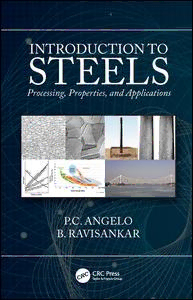Table Of ContentIntroduction to Steels
This page intentionally left blank
Introduction to Steels
Processing, Properties, and
Applications
P. C. Angelo
B. Ravisankar
CRCPress
Taylor&FrancisGroup
52VanderbiltAvenue,
NewYork,NY10017
©2019byTaylor&FrancisGroup,LLC
CRCPressisanimprintofTaylor&FrancisGroup,anInformabusiness
NoclaimtooriginalU.S.Governmentworks
Printedonacid-freepaper
InternationalStandardBookNumber-13:978-1-138-38999-1(Hardback)
Thisbookcontainsinformationobtainedfromauthenticandhighlyregardedsources.
Reasonableeffortshavebeenmadetopublishreliabledataandinformation,buttheauthor
andpublishercannotassumeresponsibilityforthevalidityofallmaterialsorthe
consequencesoftheiruse.Theauthorsandpublishershaveattemptedtotracethecopyright
holdersofallmaterialreproducedinthispublicationandapologizetocopyrightholdersif
permissiontopublishinthisformhasnotbeenobtained.Ifanycopyrightmaterialhasnot
beenacknowledgedpleasewriteandletusknowsowemayrectifyinanyfuturereprint.
ExceptaspermittedunderU.S.CopyrightLaw,nopartofthisbookmaybereprinted,
reproduced,transmitted,orutilizedinanyformbyanyelectronic,mechanical,orother
means,nowknownorhereafterinvented,includingphotocopying,microfilming,and
recording,orinanyinformationstorageorretrievalsystem,withoutwrittenpermissionfrom
thepublishers.
Forpermissiontophotocopyorusematerialelectronicallyfromthiswork,pleaseaccess
www.copyright.com(http://www.copyright.com/)orcontacttheCopyrightClearance
Center,Inc.(CCC),222RosewoodDrive,Danvers,MA01923,978-750-8400.CCCisanot-for-
profitorganizationthatprovideslicensesandregistrationforavarietyofusers.For
organizationsthathavebeengrantedaphotocopylicensebytheCCC,aseparatesystemof
paymenthasbeenarranged.
TrademarkNotice:Productorcorporatenamesmaybetrademarksorregisteredtrademarks,
andareusedonlyforidentificationandexplanationwithoutintenttoinfringe.
LibraryofCongressCataloging-in-PublicationData
Names:Angelo,P.C.,author.|Ravisankar,B.,author.
Title:Introductiontosteels:processing,properties,andapplications/P.C.Angeloand
B.Ravisankar.
Description:NewYork,NY:CRCPress/Taylor&FrancisGroup,2019.|Includes
bibliographicalreferencesandindex.
Identifiers:LCCN2018052858|ISBN9781138389991(hardback:acid-freepaper)|ISBN
9780429423598(ebook)
Subjects:LCSH:Steel–Metallurgy.
Classification:LCCTN730.A582019|DDC669/.142–dc23
LCrecordavailableathttps://lccn.loc.gov/2018052858
VisittheTaylor&FrancisWebsiteat
http://www.taylorandfrancis.com
andtheCRCPressWebsiteat
http://www.crcpress.com
Contents
Preface ......................................................... ix
AuthorBios..................................................... xi
1 Iron-CarbonDiagram......................................... 1
1.1 Iron-CarbonDiagram ...................................3
1.2 SlowCoolingofEutectoidComposition....................7
1.3 SlowCoolingofHypoeutectoidComposition...............8
1.4 SlowCoolingofHypereutectoidComposition ..............9
2 HeatTreatmentofSteels..................................... 11
2.1 Annealing............................................12
2.2 Normalizing..........................................13
2.3 Hardening............................................14
2.4 Hardenability.........................................18
2.5 Tempering............................................20
2.6 Martempering.........................................21
2.7 Austempering.........................................21
2.8 Ausforming...........................................22
2.9 Isoforming............................................23
2.10 PrecipitationHeatTreatment............................23
3 SurfaceHardening .......................................... 27
3.1 CaseHardening.......................................27
3.2 ChemicalSurfaceHardening............................28
4 PlainCarbonSteels.......................................... 31
4.1 LowCarbon(or)MildSteels ............................31
4.2 MediumCarbonSteels .................................32
4.3 HighCarbonSteels ....................................32
4.4 ApplicationsasEngineeringMaterial.....................33
5 EffectofAlloyingElementsinSteel........................... 35
5.1 EffectofAlloyingElementsonIronCarbonDiagram .......35
5.2 FerriteStabilizers......................................36
5.3 AusteniteStabilizers ...................................37
5.4 NeutralStabilizer......................................39
5.5 EffectofVariousElementsasDissolvedinFerrite
Matrix ...............................................40
v
vi Contents
5.6 EffectofVariousElementsasCarbidesinFerrite/
AusteniteMatrix ......................................40
5.7 SummaryofCarbides ..................................43
5.8 DispersedMetallicParticles.............................44
5.9 NonmetallicInclusions.................................45
5.10 IntermetallicCompounds...............................46
5.11 AlloyDistributioninAustenite ..........................46
5.12 EffectofAlloyingElementsonHardening.................46
5.13 EffectofAlloyingElementsonHardenability..............48
5.14 EffectofAlloyingElementsonTempering.................49
6 LowAlloySteels............................................ 51
6.1 PlainCarbonSteels(1XXXSeries)........................52
6.2 NickelSteels(2XXX) ...................................53
6.3 Nickel-ChromiumSteels(3XXX) .........................54
6.4 MolybdenumSteels(4XXX) .............................54
6.5 ChromiumSteels(5XXX) ...............................55
6.6 VanadiumSteels(6XXX)................................55
6.7 TungstenSteels(7XXX).................................55
6.8 TripleAlloySteels(8XXXand9XXX) .....................55
6.9 SiliconSteels..........................................56
6.10 BoronSteels ..........................................56
6.11 InterstitialFreeSteels ..................................57
6.12 ApplicationsasEngineeringMaterial.....................62
7 HighStrengthSteels......................................... 65
7.1 DefinitionandNeedofHighStrengthSteels...............65
7.2 TypesandProblemsinDevelopingHighStrength
Steels ................................................67
7.3 MetallurgyofHighStrengthSteels.......................78
7.4 ApplicationsParticularlyforAutomotives.................80
8 HighAlloySteels ........................................... 83
8.1 MaragingSteels .......................................83
8.2 StainlessSteels ........................................92
8.3 ToolSteels...........................................116
9 SelectionofMaterials....................................... 125
9.1 ToolsUsedforSelectionofMaterials ....................125
9.2 SystemizedSelectionofMaterials.......................126
9.3 CaseStudies .........................................127
Contents vii
SubjectiveQuestions ...........................................133
Objectivequestions.............................................139
Bibliography...................................................145
Index .........................................................149
This page intentionally left blank
Preface
Steel is adapting itself to emerging structural standards and conditions.
From 1778, when the first iron bridge was built, to the present, steel is the
mostcommonlyusedmaterialforvariousapplications.Steelisappropriate
to most critical requirements by the addition of alloying elements and by
suitable heat treatment. Steels are also most suitable for manufacturing by
forming, welding, casting, and machining. There are several standard
books that deal with the metallurgy of steel but they are meant for
metallurgical engineers and are not suitable for engineers from other
disciplines including mechanical, production, electrical, electronics, and
aeronautical engineering students. It is to fulfill this requirement that
Introduction to Steel: Processing, Properties, and Applications has been written.
It will also be useful for practicing engineers. We also expect the book to
satisfy the needs of students preparing for competitive exams.
This book consistsof nine chapterscovering most of the important types
of steels and their physical metallurgy, microstructure, and engineering
applications. Chapter 1 introduces the iron-carbon diagram and discusses
the importance and interpretation of it as well as the resultant microstruc-
ture under equilibrium conditions with respect to carbon content. The
effect of nonequilibrium cooling (heat treatment) on properties and meth-
odology of heat treatment are discussed in Chapter 2. The most important
surface hardening methods and methodology are described in Chapter 3.
Chapter 4 deals with the various plain carbon steels and their heat treat-
ment as well as important applications as engineering material. The effect
of alloying elements on phase stability, microstructure, and properties are
discussed in Chapter 5. The properties and applications of steel with low
amounts of alloying elements are described in Chapter 6. High-strength
steels are discussed in Chapter 7, in particular their applications for
specialized uses in automobiles and aerospace. Chapter 8 covers high
alloy steels – in particular maraging steels, stainless steels, and tool
steels – describing their special uses in various applications. The basic
techniques of the selection of material illustrated through case studies are
included in Chapter 9. In addition, the book contains both subjective and
objective questions as an aid to students preparing for semester-end and
competitive exams.
This book is based on our many years of teaching undergraduate and
postgraduate students of various engineering disciplines. It is our fond
hopethatthepresentbookwillserveasatextbookforcoursesinengineer-
ing and also as a useful reference book for practicing engineers. We look
forward to receiving your valuable response and suggestions.
ix

